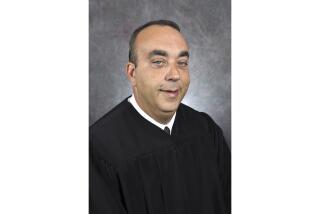Paul C. Marcinkus, 84; Cleric Presided Over Vatican Bank Tied to Italian Finance Scandal
Archbishop Paul C. Marcinkus, who presided over the Vatican Bank when it was linked with the failure of Italy’s largest private bank in 1982, has died. He was 84.
Marcinkus was found dead Monday at his home in Sun City, Ariz., said Mary Jo West, a spokeswoman for the Roman Catholic Diocese of Phoenix. A cause of death was not immediately announced.
His 18-year tenure as president of the Vatican Bank linked Marcinkus to major financial scandal, mysterious deaths and a criminal probe connected to the 1982 failure of Banco Ambrosiano, then Italy’s largest private bank, after $1.3 billion of its assets had disappeared.
Marcinkus was charged with being an accessory to the bank’s bankruptcy, which was found to be fraudulent. But he was never arrested. The Vatican, a major shareholder in Banco Ambrosiano, paid $250 million to the failed institution’s creditors in what it called a goodwill settlement. It also denied any moral or legal blame.
Marcinkus always staunchly denied any involvement in the bank’s failure and said the Catholic Church should not have made the payment.
“The Italians should have looked into their own banking system,” he told reporters in 1990. “It’s very easy to blame someone else.
“I have never done anything wrong,” he said.
Two Italian bankers with whom Marcinkus dealt were convicted of fraud after their banks collapsed -- Roberto Calvi of Banco Ambrosiano and Michele Sindona, a Sicilian financier whose banking empire crashed in 1974.
Both men died mysteriously. Calvi was found hanging from Blackfriars Bridge in downtown London in 1982. Sindona, a former Vatican financial advisor, died in jail in 1986 after drinking coffee laced with cyanide.
After Calvi’s death, Marcinkus was questioned about “letters of comfort” he had written that implied that the Vatican Bank, officially known as the Institute for Religious Works, would make good on Ambrosiano’s debts. However, the archbishop said Calvi had released him in writing from any such liabilities.
Warrants for the arrest of Marcinkus and two lay Vatican officials were issued in 1987 after they were charged with involvement in the fraudulent bankruptcy of the Milan-based Banco Ambrosiano.
The arrests were never made. The charges were dropped in 1988 after an Italian court ruled that Italy had no jurisdiction over the affairs of Vatican City, an independent city-state.
Calvi’s death was initially ruled a suicide, but British police reopened the case in 2003. Italian police have said they believe that Calvi was murdered by the Mafia, and five people are now being tried on murder charges.
“What is certain is that the Vatican bank acted as a fiduciary shield and hidden partner in a very complex financial construction,” said a September 2004 report prepared by Bank of Italy inspector Francesco Guiffrida, the Montreal Gazette reported last fall.
After a 1989 Vatican restructuring eliminated Marcinkus’ position at the bank, he told Reuters, “I have no doubt that I will be remembered as the villain in the Calvi affair.”
The archbishop, who was known for saying that “You can’t run the church on Hail Marys,” was kept a virtual prisoner in the Vatican for long stretches in the 1980s. The church refused to let him be questioned, and Italian magistrates retaliated by threatening to arrest him if he left Vatican City.
“Marcinkus is ... a man who in the normal world would have served a long prison sentence for his part in a whole array of financial crimes,” British author David Yallop, who wrote about the scandal in the 1984 book “In God’s Name,” told the Phoenix New Times in 2003.
The controversy led to an overhaul of Vatican Bank operations, including daily oversight by lay experts. With the abolishment of the president’s job, a commission of cardinals provided overall supervision of the bank.
After leaving the Vatican bank, Marcinkus kept his second job as vice president of the Vatican city-state. But a career that many thought destined him for the red hat of a cardinal was virtually over.
In 1990, he resigned and returned to Chicago to become a parish priest. He retired to Sun City, where he remained involved with a local church.
Paul Casimir Marcinkus was born Jan. 15, 1922, in Cicero, Ill., the youngest of five children of Lithuanian immigrants. His father was a window washer; his mother worked in a bakery.
At 25, he was ordained and served as a priest in Chicago before going to Rome in the 1950s. He received a doctorate in canon law from the Pontifical Gregorian University in Rome and joined the Vatican’s diplomatic corps.
His size -- he was a beefy 6-foot-4 -- made him an obvious choice as an unofficial papal bodyguard and advance security man.
Twice Marcinkus helped save a pope’s life. He overpowered a Bolivian painter who tried to kill Pope Paul VI with a knife during a 1970 trip to the Philippines. During Pope John Paul II’s 1982 visit to Portugal, he shoved aside a Spanish priest who lunged at the pope with a bayonet.
An avid athlete, Marcinkus told tales about trying to teach Italian boys to play baseball. He regularly played golf and tennis at a club in Rome.
While working in the English section of the Vatican’s secretariat of state, Marcinkus met the bishop who would become Pope Paul VI in 1963.
The assertive American’s abilities and loyalty impressed the shy pope, yet many were surprised when Pope Paul VI made Marcinkus secretary of the Vatican Bank in 1969 and president two years later. Named a bishop in 1968, Marcinkus had no previous financial experience.
More to Read
Sign up for Essential California
The most important California stories and recommendations in your inbox every morning.
You may occasionally receive promotional content from the Los Angeles Times.











